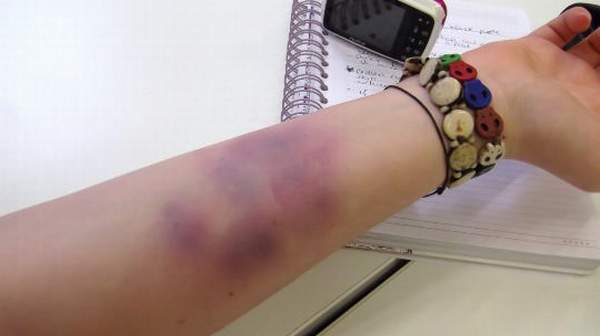What's in this article?
Bruises Overview
A bruise is a common skin injury that results in a discoloration of the skin. Blood from damaged blood cells deep beneath the skin collects near the surface of the skin, resulting in what we think of as a black and blue mark.
If your skin isn’t broken, you don’t need a bandage. But you can enhance bruise healing with these simple techniques:
- Elevate the injured area.
- Apply an ice pack wrapped in a towel or a cloth dampened with cold water. Do this for about 10 minutes. Repeat several times a day for a day or two after the injury as needed.
- Rest the bruised area, if possible.
- Consider acetaminophen (Tylenol, others) for pain relief, or ibuprofen (Advil, Motrin IB, others) for pain relief and to reduce swelling.
Bruises Causes and Risk Factors
People typically get bruises when they bump into something or when something bumps into them. Risk factors for bruises include the following:
- Bruises can occur in some people who exercise rigorously, such as athletes and weight lifters. These bruises result from microscopic tears in blood vessels under the skin. Bruising in athletes can also result from direct impact/trauma and be accompanied by an underlying hematoma.
- Unexplained, random bruises that occur easily or for no apparent reason may indicate a bleeding disorder or result from blood-thinning medications (anticoagulants), especially if the bruising is accompanied by frequent nosebleeds or bleeding gums.
- Often, what are thought to be unexplained bruises on the shin or the thigh, for example, actually result from bumps into a bedpost or other object and failing to recall the injury.
- Bruises in elderly people frequently occur because their skin has become thinner with age. The tissues that support the underlying blood vessels have become more fragile.
- Bruising occurs more commonly with vitamin C deficiency (ascorbic acid deficiency or scurvy).
- Bruising can be a sign of physical abuse of the child (child abuse).
Symptoms of a Bruise
- Initially, a fresh bruise may actually be reddish. It will then turn blue or dark purple within a few hours, then yellow or green after a few days as it heals.
- A bruise is commonly tender, and sometimes even painful for the first few days, but the pain usually goes away as the color fades.
- Because the skin is not broken in a bruise, there is no risk of infection.
Diagnosis of Bruises
If an injury is obviously a bruise and the doctor does not suspect any broken bones, the doctor will probably not perform any tests.
- If there is swelling or severe pain, the doctor may get an X-ray of the area to make sure there are no broken bones.
- If bruising occurs frequently and for no apparent reason, the doctor may have blood tested to look for a bleeding disorder.
- Certain bruises, a pattern of bruises over time and in various stages of healing may alert a doctor to the possibility of physical abuse.
Bruises Home Treatment Remedies
The treatment for a bruise is most effective right after the injury, while the bruise is still reddish.
- A cold compress such as an ice pack or a bag of frozen vegetables should be applied to the affected area for 20-30 minutes in order to speed healing and reduce swelling. Do not apply ice directly to the skin. Wrap the ice pack in a towel.
- If the bruise takes up a large area of the leg or foot, the leg should be kept elevated as much as possible during the first 24 hours after the injury.
- Acetaminophen may be taken for pain as instructed on the bottle. Avoid aspirin or ibuprofen because they slow the blood from clotting and may, in fact, prolong the bleeding.
- After about 48 hours, heat in the form of a warm washcloth applied to the bruise for 10 minutes or so two to three times a day may increase blood flow to the bruised area, allowing the skin to reabsorb the blood more quickly. Ultimately, the bruise will fade in color.
Prevention of Bruises
- Wear protective gear while playing contact sports such as soccer, football, or hockey.
- Place furniture away from doorways and common walking paths within the home.
- Keep phone and electrical cords away from open areas where one may trip and fall.
- Be sure floors are kept dry and rugs are slip resistant.
- Keep floors free of clutter.
- Install a small night light or use a flashlight if one needs to walk to the bathroom during the night.
- If a doctor has prescribed anticoagulant medications (blood thinners), have regular monitoring and adjust medications as necessary.







